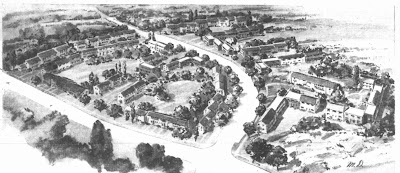 |
| September 9, 1918 |
September 9, 1918 - Camp Brooks opens for flu victims
September 3, 1946 - Ground broken for Hancock Village
September 8, 1966 - Brookline one of first seven communities in METCO
September 8, 1975 - JFK birthplace damaged in anti-busing attack
September 9, 1918
Camp Brooks open for flu victims
The Brookline company of the Massachusetts Guard erected an open-air tent camp on the east side of Corey Hill to treat virulent cases of influenza that had struck merchant marine trainees in Boston Harbor. The camp was called Camp Brooks after noted surgeon William A. Brooks, surgeon-general of the State Guard, whose hospital (now condominiums) was on Summit Avenue.
The camp, shown at the top of this post and below in photos from the National Archives, treated patients outdoors under the theory that fresh air and sunshine would aid in their recovery. Thirty-five of the 351 patients treated at the hospital died, a much lower rate, according to Brooks, than in indoor hospitals despite the fact that the open air hospital took in some of the worst cases.
 |
| A nurse getting water at Camp Brooks (Photo via National Archives) |
The camp operated for a little more than a month. Read more about Camp Brooks and 1918 flu pandemic in Brookline in these Muddy River Musings blog posts: Part 1 | Part 2.
September 3, 1946
Ground broken for Hancock Village
Governor Maurice Tobin joined other state, Federal, and local officials to break ground for 250 homes for returning veterans and their families in South Brookline and West Roxbury. The Hancock Village project was financed by the John Hancock Life Insurance Company and announced in an ad in the Brookline Chronicle.
September 3, 1946
Ground broken for Hancock Village
Governor Maurice Tobin joined other state, Federal, and local officials to break ground for 250 homes for returning veterans and their families in South Brookline and West Roxbury. The Hancock Village project was financed by the John Hancock Life Insurance Company and announced in an ad in the Brookline Chronicle.
"Hancock Village [announced the company in the nearly full-page ad] is the first of this company's answers to the nation's housing crisis. It will build upon the soundest principles of healthful living with safety of homes and roads particularly stressed...With the present acute need for housing, especially for veterans, the importance of this activity is obvious."
 |
| This sketch of the future Hancock Village development appeared in the Brookline Chronicle and in Boston newspapers |
James Love, a World War II veteran and an amputee from Brookline, joined a National Housing Agency administrator in turning the first spadeful of earth, using "a regulation G.I. foxhole shovel," reported the Chronicle.
September 8, 1966
Brookline one of first communities in METCO
75 children from the Roxbury, Dorchester, and the South End neighborhoods began school in Brookline as part of the METCO program. The students included 25 children enrolled in Brookline High School and 50 in the various K-8 schools.
Brookline was one of seven Massachusetts communities participating in the METCO program at its launch. Dr. Leon Trilling, an MIT professor and the president of the Brookline School Committee, was one of the driving forces behind the creation of the METCO program.
The broad purpose of the METCO program, according to a 1966 report of the School committee
"is to promote quality integrated education and to develop modes of cooperation between urban and suburban school systems in the Greater Boston area. It aims to provide a more meaningful educational experience for both city and suburban children."
September 8, 1975
JFK birthplace damaged in anti-busing attack
JFK birthplace damaged in anti-busing attack
An unidentified man threw a Molotov cocktail into the kitchen at the rear of the John F. Kennedy birthplace in protest of Senator Edward (Ted) Kennedy’s support of Boston school integration through busing. The attack caused an estimated $30,000 in damage to the Beals Street home.
Two men were seen driving away from the site after the attack. They left a message -- "Bus Teddy" -- scrawled on the sidewalk in front of the home. The fire and smoke damaged the kitchen and an upstairs bedroom at the house.
 |
| The message "Bus Teddy" can be seen on the sidewalk in front of the JFK birthplace in this AP photo |
The site, run by the National Park Service, was closed for more than a year while repairs were made.

No comments:
Post a Comment